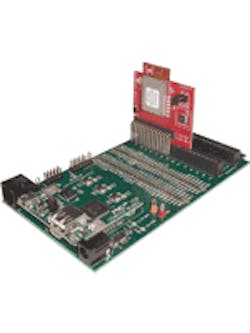Should You Choose Standard Or Custom P2P Wireless?
Standards like ZigBee and 802.11n provide performance and flexibility. However, their overhead and costs may be unnecessary for many applications, especially for low-power devices. Applications may need dozens of nodes that a range of proprietary options can handle easily. This approach locks designers into a particular platform, but this can be an advantage. There are almost as many options as there are wireless microcontroller vendors.
SIMPLY WIRELESS
Texas Instruments started the trend many years ago (see “$1 Arms And $20 Development Kits”) with the original eZ430-F2013 (Fig. 1). Its latest incarnation shows up in the eZ430-Chronos (see “Low-Cost Kits Make Evaluation Easier”).
TI has plenty of wireless options, including 802.15.4 and ZigBee. But it also has the SimpliciTI network protocol, which is a proprietary, low-power protocol targeting networks under 100 nodes that have a low data rate and low communications duty cycle. It uses minimal resources, allowing it to run on TI’s MSP430.
Even though it’s a low-overhead system, SimpliciTI can handle a multihop peer-to-peer (P2P) network. Range extenders can handle up to four hops. Security is optional, like many proprietary protocols. This is important for applications such as metering and security systems.
CyFi FOR CONTROL
Cypress Semiconductor has a flexible line of microcontrollers called PSoC. Its CyFi development kit (Fig. 2) is based on the PSoC 1, which is now complemented by the 8051-based PSoC 3 and ARM-based PSoC 5 (see “Field-Programmable I/O Augments 8- And 32-Bit Microcontrollers”). The newer platforms easily handle the protocol.
The 2.4-GHz RF solution employs direct-sequence spread spectrum (DSSS), allowing it to operate in environments with other RF gear. It implements a star network protocol using only 6 kbytes of code for a regular node and 8 kbytes for a hub. Active power management keeps the chips sipping less often from the battery trough.
MY MiWi
Microchip’s MiWi protocol is built on 802.15.4. Serial peripheral interface (SPI) modules like Microchip’s MRF24J40 implement the MiWi protocol (Fig. 3). It offers much of the flexibility of ZigBee. But like SimpliciTI and CyFi, developers get the protocol stack for free.
Platforms like ZigBee are a basic requirement for many applications. But if that box is unchecked, one of these alternatives may be more effective.
About the Author
William G. Wong
Senior Content Director - Electronic Design and Microwaves & RF
I am Editor of Electronic Design focusing on embedded, software, and systems. As Senior Content Director, I also manage Microwaves & RF and I work with a great team of editors to provide engineers, programmers, developers and technical managers with interesting and useful articles and videos on a regular basis. Check out our free newsletters to see the latest content.
You can send press releases for new products for possible coverage on the website. I am also interested in receiving contributed articles for publishing on our website. Use our template and send to me along with a signed release form.
Check out my blog, AltEmbedded on Electronic Design, as well as his latest articles on this site that are listed below.
You can visit my social media via these links:
- AltEmbedded on Electronic Design
- Bill Wong on Facebook
- @AltEmbedded on Twitter
- Bill Wong on LinkedIn
I earned a Bachelor of Electrical Engineering at the Georgia Institute of Technology and a Masters in Computer Science from Rutgers University. I still do a bit of programming using everything from C and C++ to Rust and Ada/SPARK. I do a bit of PHP programming for Drupal websites. I have posted a few Drupal modules.
I still get a hand on software and electronic hardware. Some of this can be found on our Kit Close-Up video series. You can also see me on many of our TechXchange Talk videos. I am interested in a range of projects from robotics to artificial intelligence.

